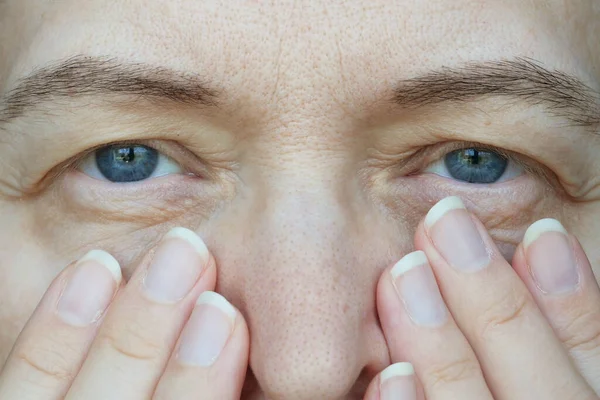Ptosis is one of the common reasons for your low-lying eyelids. When this condition affects one eye, it is known as unilateral ptosis, but it’s called bilateral ptosis when it affects both eyes. Damage to the nerves, underlying illnesses, or severe conditions like neurological disorders or stroke can cause your eyelids to drop. In the sections below, we have shared more about ptosis, from the causes, types, and treatment options.
What is Acquired Ptosis?
Ptosis is classified into two main types: congenital ptosis and acquired ptosis. Congenital ptosis refers to the condition that is present at birth. On the other hand, acquired ptosis often occurs later in life. These conditions can be temporary, permanent, or recurring, meaning they could come and go.
Adults can develop ptosis when the primary muscle responsible for lifting the eyelids, i.e., the levator muscle, separates or stretches from the eyelids. Both aging and eye injuries may contribute to this condition. The low-lying eyelids could be barely detectable, or they could sag so much that it covers your pupil. Droopy upper eyelids may significantly impair or completely block vision. This often depends on the primary cause of the condition and how the pupil is hidden from view.
What Causes Acquired Ptosis
Ptosis develops once the levator muscle fails to contract properly. Below are the common causes of acquired ptosis.
Aging
Low-lying eyelids can develop due to the gradual degeneration of the muscles that support the eyelid. Most people who develop droopy eyelids due to aging choose not to seek medical intervention unless the condition adversely affects their quality of life. In most cases, such patients often have other underlying health conditions, e.g., diabetes, glaucoma, cataracts, etc.
Acquired Mitochondrial Myopathy
This includes several acquired diseases or conditions that impact the body’s muscles. Mitochondrial myopathy symptoms include muscle atrophy, decreased exercise capacity, and weak skeletal muscles.
Causes include adverse effects of drugs, adverse respiratory tract infections, and environmental factors. And while there’s no cure for this condition, management techniques are pretty effective. This includes keeping your eyes healthy through proper nutrition, hydration, exercising, taking vitamin/amino acid supplements, etc.
Reduced Blood Flow
During a stroke, for example, a blockage in the blood flow to some parts of the brain can impair the nervous system, causing one or both eyelids to droop. More often, ptosis occurs in patients with known cases of hemispheric strokes. Bilateral ptosis can be caused by tissue death due to artery blockage, mechanical compression, or rupture in the delicate brain or facial regions.
Damage to Peripheral Nerves
Low-lying eyelids can also result from damage to the peripheral nervous system that supports eyelid function. Most nerves outside the spinal cord and the brain are crucial in communication, body regulation, and control of involuntary bodily functions. Injuries or physical damage to a third nerve or the central nervous system can impair the closing and opening of the eyelid.
Types of Acquired Ptosis
Acquired ptosis can be grouped into five distinct groups. These are:
- Myogenic ptosis. This is caused by other eye conditions that affect the levator muscle, such as myasthenia gravis and myotonic dystrophy.
- Aponeurotic ptosis. This occurs due to aging, which causes the levator muscle to weaken. It means the muscle cannot lift the eyelid into the correct position.
- Mechanical ptosis. Here, the eyelids become too heavy for the levator muscle to lift. This is caused mainly by an eyelid tumor or growth, which becomes heavier with time.
- Neurogenic ptosis. This is caused by nerve damage or conditions affecting the central nervous system.
- Traumatic ptosis. Occurs following some trauma or physical injury to the levator muscle or sensitive eye tissues.
Treatment Options
Before your doctor can recommend any treatment, regular eye examination and monitoring are usually performed. Typically, your ophthalmologist will identify the cause of your ptosis before suggesting a treatment plan.
This also helps highlight any underlying health issues and whether some treatment options could lead to complications. For instance, Botox injection and surgery may not always work well for older patients or those with chronic conditions.
When this is the case, the doctor will recommend using minimally invasive treatment options such as eyedrop. A perfect example is Upneeq, an FDA-approved prescription eyedrop that helps lift the upper eyelids for improved vision.
In adverse situations and where the risk of complications is low, the doctor may recommend surgery to improve the function of the eyelid muscles. Your ophthalmologist might also trim excess skin and tuck the muscle that raises the eyelid.
The Bottom Line
Regardless of what causes your ptosis, you can choose any of the different treatment options to match your unique needs. Most adults who develop ptosis can choose either surgery, eyedrop treatment, or Botox injection. Not all these options will work for every patient, so it’s best to consult an expert ophthalmologist before making up your mind. An excellent place to start is to discuss the risks and benefits of each treatment method for better decision-making.








